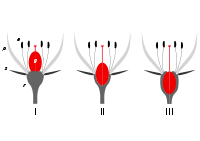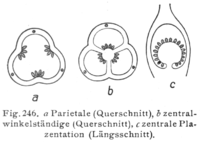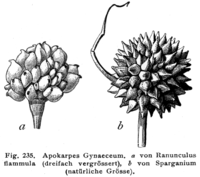Gynoecium
![]()
This article deals with the botanical term. For the women's wing in the dwelling house of ancient Greece, see gynaikonitis.
Gynoeceum, also gynaeceum or gynoecium (both Latinized forms of ancient Greek γυναικεῖον gynaikeíon "female dwelling") refers to the entirety of the megasporophylls (carpels - colloquially: "female" floral organs) of the flowers of seed plants. Carpels carry the ovules in which the embryo sac cell (megaspore) and the resulting female gametophyte develop; after fertilization of the ovule of the gametophyte, the seed is formed (see also: seed plants, alternation of generations).
The components of the gynoecium are involved in the formation of the fruit in angiosperms. The shape and composition of the gynoecium are important features in assessing the systematic position of plant taxa. The morphology of the gynoecium plays a crucial role in pollination and seed dispersal and can thus provide information on aspects of the ecology of a plant.
In the angiosperms the carpels are arranged spirally or whorled on the flower axis. The carpels of angiosperms are divided into a lower, fertile area with the ovules, the ovary and an upper, sterile section, the stylus, the upper end of which is the stigma, which serves to receive the pollen grains. The term pistil is often used here.
Carpels are congenitally tubularly fused from below (congenital: the fusion is already laid out when the tissue is formed). Part of the overlying area fuses postgenitally; the suture of the postgenital fusion (suture) is visible in the carpels of many taxa. On both sides of the boundary, the ovules form inside the carpel; the tissue from which the ovules arise is called the placenta. On the dorsal side of the carpel, opposite to the suture, and in the placentas run vascular bundles.
The section of the flower axis with the carpels is in different position to the androeceum or the perianth, in some taxa axis tissue forms an internode and thus raises the other flower organs and/or the gynoeceum (see under ovary). Original gynoeceans are thought to have been composed of a number of detached carpels. In the course of evolution, forms with few or only one carpel have developed (oligomerization), as well as gynoecia with intergrown carpels. Gynoecia with free carpels are called choricarp or apocarp, gynoecia with fused carpels are called coenocarp.

Position of the ovary. I superior II intermediate III inferior. a androeceum g gynoeceum p corolla petals s sepals r flower axis

Transverse section of a capsule fruit of flax with true and false septa (f). Figure 238 from Hegi, G. (1906), op. cit.

Placentation of gynoecium:, a coenocarp-paracarp; parietal, b coenocarp-syncarp; central-angular, c central. Figure 246 from Hegi, G. (1906), op. cit.

Apocarpous gynoecium of the burning buttercup (a) and of a hedgehog bulb (b). Figure 235 from Hegi, G. (1906): Illustrierte Flora von Mittel-Europa. Published by J. F. Lehmann, Munich.
Apocarpous gynoecia, morphology of the carpels.
→ Main article: Ovary
Apocarpic or choricarpic, multicarpellate gynoeceae consist of several and not intergrown carpels. An apo-, choricarp gynoecium is formed, for example, by the buttercups. A unicarpic, unicarpellate gynoecium with only a single carpel is also possible.
Also several partly fused ovaries can be present at the same time. It is possible that adjacent carpels are only partially, barely fused with free styles (hemi-apocarpous, semicarpous) or are connected by the receptacle (pseudo-coenocarp). Rarely, two or more ovaries of different flowers may be completely or partially fused to form a syngynium (pseudo-monomer).
Coenocarpus Gynoeceae
In coenocarpic and syn- or paracarpic gynoecium the carpels are fused together with free or fused styles. In the case of carpels fused along their entire length, the number of stigmatic lobes may give an indication of the number of carpels involved in the formation of the gynoecium.
In cross-section, the ovaries of coeno-syncarpous gynoecia reveal a number of compartments, chambers (loculi, loculaments) corresponding to the interiors of the fused carpels. The compartments are separated by true septa (septa) formed by the lateral surfaces of the carpels. A coeno-syncarpous gynoecium is found, for example, in the lily family.
In coeno-paracarpous ovaries no or only weakly developed septa are formed, they usually have an unchambered interior.
In some plants, invaginations or septa are found in the ovary which are not due to the lateral surfaces of fused carpels, but arise from growth, proliferation from the surface of the carpels or from placental tissue ("false septa"), e.g. in some cruciferous plants.
If the true septa of the carpel margins in the center of the ovary are free from each other, it is incompletely septate (hemi-syncarp, -paracarp). In an ovary there may be sections of more or less fanned and/or unfanned areas, or there may be different placentations as in the pomegranate. A continuous column (columella) can also form in the middle of the ovary. In many cases the carpels in the basal area are syncarpous, whereas further distally they are paracarpous. Therefore it is often no longer distinguished between coeno-paracarpous and -syncarous, but only all coenocarpous ovaries are generally called syncarpous.
Questions and Answers
Q: What is a gynoecium?
A: A gynoecium is the female reproductive parts of a flower.
Q: What are the male parts of a flower called?
A: The male parts of a flower are called the androecium.
Q: Do all flowers have both female and male parts?
A: No, not all flowers have both female and male parts.
Q: What is a carpel?
A: A carpel is a building block of a pistil.
Q: What are the parts of a carpel and pistil?
A: The parts of a carpel and pistil are a stigma at the top where the pollen lands, a style, and an ovary.
Q: What are plant ovaries?
A: Plant ovaries are the parts of the gynoecium that contain ovules.
Q: What is the function of the stigma?
A: The stigma is the pollen receptor at the top of the carpel.
Search within the encyclopedia